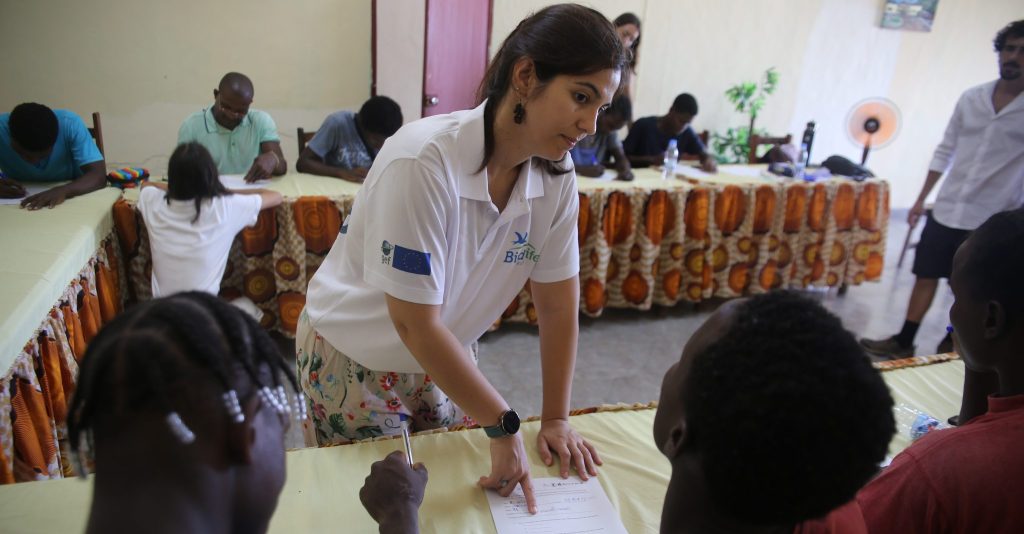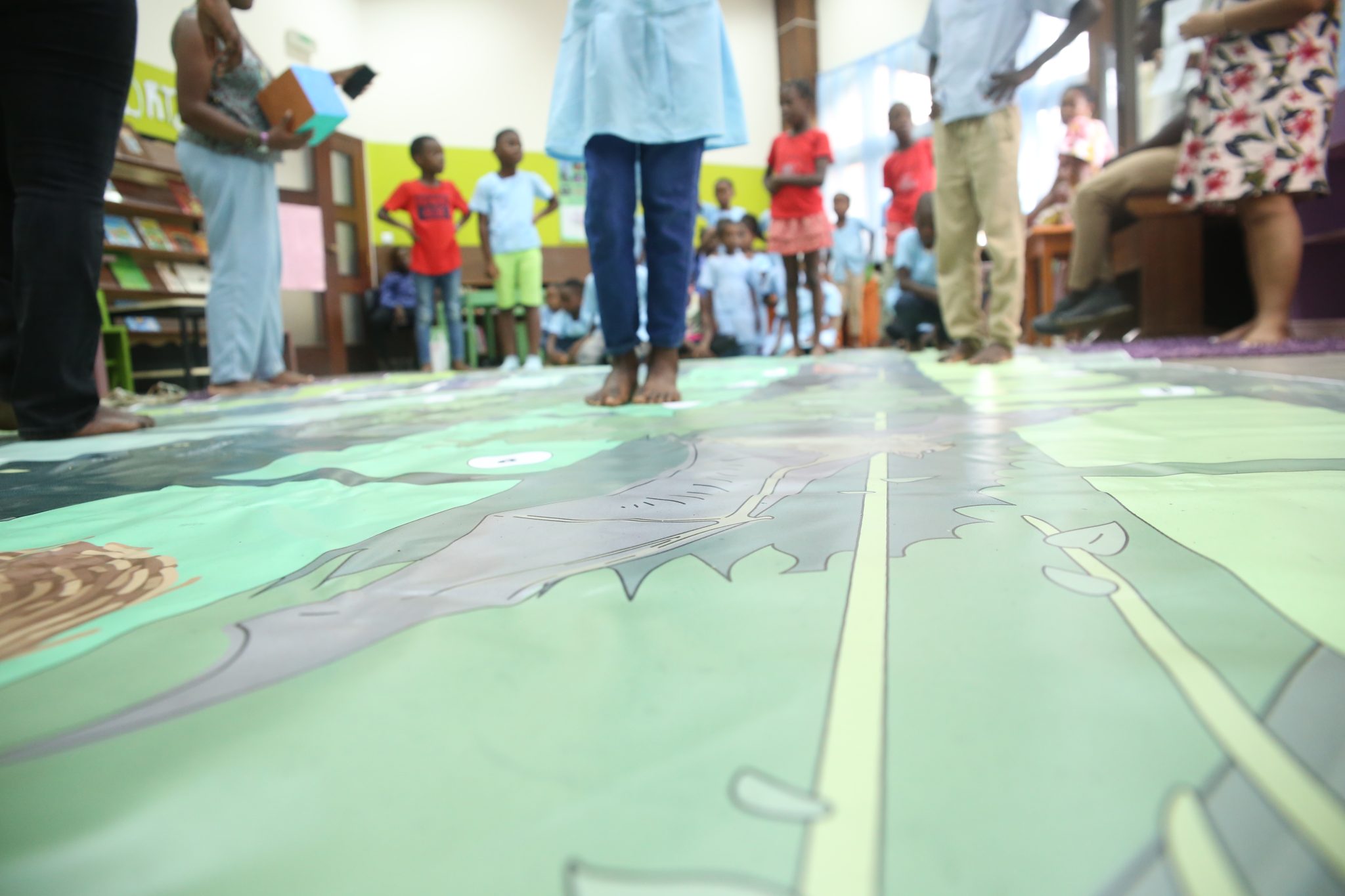Striking a balance between hunting and conservation in São Tomé and Príncipe

In São Tomé and Príncipe, BirdLife is working with local communities to protect the country's unique biodiversity.
By Vânia Trovoada
On the distant horizon, one can hear the breeze whispering through the trees as the branches sway in a graceful dance. The breeze is punctuated by the flutelike pitch of a thrush calling out in periodic intervals. Against this euphony, a group of men make its way on a winding path, stopping at intervals to scan the thick bushes with high-powered binoculars.
Dressed in baggy grey khakis and a short-sleeved brown shirt, Gabriel Cabinda leads the team of researchers slowly along the path. “Today, we are on the lookout for the elusive Sao Tome Ibis”, explains Cabinda.
Often described as the Galapagos of Africa, the islands of São Tomé and Príncipe (STP) off the coast of Central Africa are home remarkable high number of endemic species of fauna and flora, making this archipelago extremely important for biodiversity conservation in the Gulf of Guinea.
Almost one-third of the islands are made of protected areas (PAs), and over 12,000 hectares consist of the newly created Special Reserves (SRs), that encompass forests, savannahs, and a mangrove. Within these islands other than the endemic seven mammals, eight amphibians, 17 reptiles and hundreds of plants, there are 28 endemic bird species, some of which are critically endangered of extinction, like the Sao Tome Green Pigeon (Treron sanctithomae).
“The biodiversity of Sao Tome and Principe is very rich in species of fauna and flora. We have a very favourable climate. We have many species, especially endemic species [and] we know today, that endemism is very inviting” notes Atanásio Bandeira, STP Forest and Biodiversity Directorate Officer.
Several of the endemic birds on the islands are threatened by introduced mammals, including monkeys, African civets, wild pigs, and cats, as well as opportunistic hunting practices by local hunters. During public consultations for the revision of the Management Plans for STP’s Natural Parks in 2021, local communities raised the issue of unregulated hunting as a concern, both regarding the decrease in abundance of prey species and the associated loss of income.
Small project, big ambitions, bigger results
Following these consultations, The project “Build national capacity and capability to regulate hunting and protect biodiversity”, financed by the Darwin Initiative and implemented by BirdLife International, the Directorate of Forests and Biodiversity, the Platform for Responsible and Sustainable Tourism (PTRS), the Centre for Ecology Evolution and Environmental Changes (CE3C) and Cibio, began in June 2022 aiming to support the necessary social and institutional changes to help conserve STP’s biodiversity through hunting, while promoting sustainable livelihoods for hunters.
As part of project activities, the project sought to build the capacity of the main stakeholders to regulate hunting and conserve STP’s biodiversity. Consequently, 18 training and awareness-raising sessions were held from November 2023 to November 2024 targeting national institutions, civil society organizations, government institutions, private sector representatives, local hunters, and consumers of hunted game. Following this training, a group of 19 former hunters and designated themselves as hunting protectors & biodiversity regulators. The former hunters have been actively participating in the project’s activities, proving to be excellent community engagement mobilisers.

“I used to be a hunter and hunted without knowing what could or could not be hunted. Through the project, I have learnt about the importance of protecting endemic bird species and thus stopped hunting”, says Ricardo da Fonseca, a hunting protector.
Further, the hunting protectors have encouraged other hunters to become more aware of their role in regulating biodiversity, and more favourable to develop alternative sustainable activities such as farming or eco-guide services to tourists or researchers. An inquiry was conducted to better understand which alternative activities would be of interest to the hunters. These actions complement the biodiversity monitoring strategy, by collecting data to inform decision-making and represent a source of funding to former hunters to further engage them in conservation.
“If we focus only on hunting, birds will disappear, because the number of hunters has increased from 10 to 20. I each of the 20 hunters hunt 4 or 5 animals per day, they will disappear. So, my main job now is to be a guide for biologists and researchers”, notes Cabinda.
Further, an awareness campaign was rolled out to raise public awareness about the importance of STP’s biodiversity. Consequently, 10 awareness sessions were held with 249 hunters and their customers participating. An interactive theatre piece performed in seven hunter-based communities reaching 475 people; a mini-documentary showcasing STP’s unique biodiversity and how hunting can help regulate it; and an ongoing school awareness campaign for children, using a giant board game called “The Biodiversity Game”.

“In awareness campaigns, we make people understand that there are other alternatives beyond hunting. The hunter is probably completely blind to this and thinks he only depends on the game, while there are other alternatives, for example, he can be a farmer, or he can be a tour guide” says Ineias Dias, a hunting protector.
As hunters become more informed about the balance between hunting and conservation, they will also become more involved in monitoring endemic and endangered species, while managing introduced species through hunting.
“Monkeys and civets have been attacking some of our endemic species. For there to be a balance of species, we must guarantee the flourishing of endemic species through tackling issues like predation and hunting” adds Dias.
Roadmap proposal for a new law
One of the key elements identified was the improvement of the current hunting law, by analysing its gaps, especially regarding the management of hunting seasons to avoid negative impacts on endemic species. In February of 2024, a round table meeting with all the project’s stakeholders was held to discuss and validate a roadmap proposal to update the current hunting law, revising it to improve efforts in the conservation of the endemic species of STP. This proposal has been shared with STP’s Directorate of Forests and Biodiversity.
“According to the law, every hunter must possess a hunting license. This license is not yet being issued, but it will in the future be issued by the Directorate of Forests and Biodiversity to hunters. For those who hunt using firearms, the hunters must have a legal weapon, legalised by the police, and then acquire a hunting license and obey the hunting calendars, which the Directorate will also produce, says Bandeira.

Looking ahead
Based on the collected interests of the hunters, a £15,000 mentorship program including capacity building on financial resource management, small conservation-based enterprises, business planning and marketing and communications has been rolled out to help define viable income alternatives for the hunters. Currently, 15 hunters from 5 districts are involved in the programme and are finalising their business pitches before presenting them at the local Entrepreneur Fair.
Hunting in STP does not have to be a threat, on the contrary, it can be a very effective activity to help preserve the amazing biodiversity of the islands and thus, create a more sustainable future for generations to come.
“Hunters can act as real regulators. Their cooperation with the Directorate of Forests and Biodiversity could have an extraordinary impact on biodiversity conservation, especially fauna. And we mustn’t let the lack of access to information jeopardise this potential.” concludes Bárbara Campos, the project’s manager and Programme Manager at BirdLife International in São Tomé and Príncipe.

Header photo: Beginning of the mentorship programme for hunters © Vânia Trovoada

“If we focus only on hunting, birds will disappear, because the number of hunters has increased.”
Gabriel Cabinda, Eco Guide.